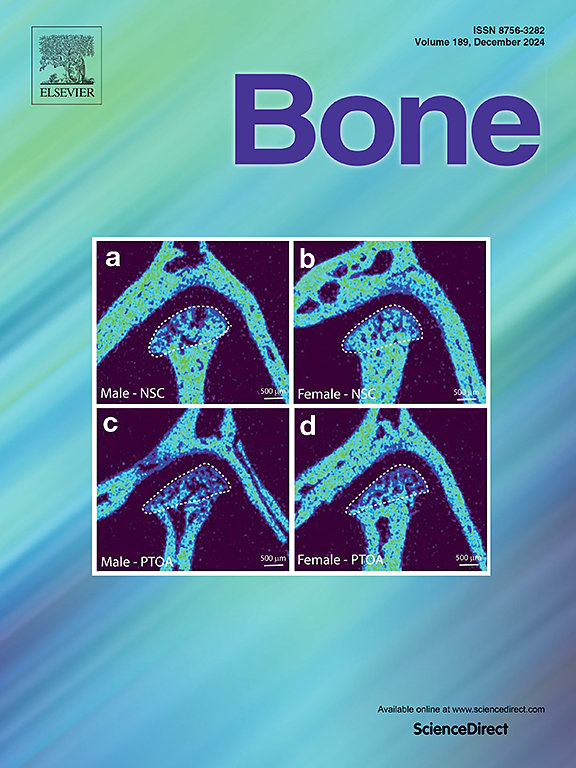美国青少年饮食碳水化合物摄入量和骨密度之间的性别特异性关联:国家健康和营养检查调查
IF 3.6
2区 医学
Q2 ENDOCRINOLOGY & METABOLISM
引用次数: 0
摘要
膳食碳水化合物摄入量与骨密度(BMD)之间的关系仍然存在争议,在青少年中缺乏这一主题的研究。本研究旨在探讨青少年膳食碳水化合物摄入量与骨密度之间的关系。方法本研究分析了2005-2010年全国健康与营养调查(NHANES)中12-19岁青少年的数据。通过两次24小时回顾评估饮食碳水化合物摄入量。采用双能x线骨密度仪(DXA)测量腰椎、全脊柱、全股骨和股骨颈的骨密度。采用为期两天的饮食加权多变量回归分析调整协变量,评估碳水化合物摄入量与骨密度之间的关系。通过分层和相互作用分析进一步评估相关性和潜在修正因素的一致性,两者均以两天饮食数据加权。此外,分层曲线拟合阐明了这种关系的性别特异性差异。结果剔除缺失数据后,共纳入2616名12-19岁青少年。在完全调整的两天饮食样本加权分析模型中,所有参与者的饮食碳水化合物摄入量与骨密度呈正相关。膳食碳水化合物摄入量与所有参与者的腰椎骨密度(β = 1.31, 95% CI = 0.38-2.23)、脊柱骨密度(β = 1.31, 95% CI = 0.39-2.24)和股骨颈骨密度(β = 0.91, 95% CI = 0.05-1.77)呈正相关。亚组分析显示显著的性别交互作用效应(P <;0.05)。随后进行分层曲线拟合和性别差异多变量回归分析。结果表明,膳食碳水化合物摄入量与男性骨密度呈正相关,而在女性中没有观察到这种相关性。多变量分析结果进一步证实了饮食碳水化合物摄入量与骨密度之间的性别差异,与最初的研究结果一致。结论:我们的研究表明,碳水化合物的摄入显著提高了青少年骨骼生长期间的骨密度。这种影响是性别特有的。本文章由计算机程序翻译,如有差异,请以英文原文为准。

Sex-specific association between dietary carbohydrate intake and bone mineral density among American adolescents: National Health and Nutrition Examination Survey
Background
The association between dietary carbohydrate intake and bone mineral density (BMD) remains controversial, and research on this topic among adolescents is lacking. This study aimed to examine the relationship between dietary carbohydrate intake and BMD in adolescents.
Methods
This study examined data from adolescents (12–19 years) in the National Health and Nutrition Examination Survey (NHANES) (2005–2010). Dietary carbohydrate intake was assessed via two 24-hour recalls. BMD at the lumbar spine, total spine, total femur, and femoral neck was measured by dual-energy X-ray absorptiometry (DXA). A two-day dietary weighted multivariate regression analysis was employed to adjusted for covariates and assess the relationship between carbohydrate intake and BMD. The consistency of the associations and potential modifying factors were further evaluated through stratification and interaction analyses, both weighted by the two-day dietary data. Additionally, stratified curve fitting elucidated sex-specific differences in this relationship.
Results
After excluding missing data, 2616 adolescents aged 12–19 years were included in the study. In the fully adjusted two-day dietary sample weighted analysis model, a positive association was observed between dietary carbohydrate intake and BMD among all participants. Dietary carbohydrate intake was positively associated with lumbar spine BMD (β = 1.31, 95 % CI = 0.38–2.23), total spine BMD (β = 1.31, 95 % CI = 0.39–2.24), and femoral neck BMD (β = 0.91, 95 % CI = 0.05–1.77) among all participants. Subgroup analyses revealed a significant sex interaction effect (P < 0.05). Subsequently, stratified curve fitting and sex-specific multivariate regression analyses were conducted. The results indicated a positive correlation between dietary carbohydrate intake and BMD in males, whereas no such correlation was observed in females. The multivariate analysis results further confirmed the sex-specific differences in the relationship between dietary carbohydrate intake and BMD, consistent with the initial findings.
Conclusion
Our study demonstrated that carbohydrate consumption significantly enhances BMD during adolescent bone growth. This effect is sex-specific.
求助全文
通过发布文献求助,成功后即可免费获取论文全文。
去求助
来源期刊

Bone
医学-内分泌学与代谢
CiteScore
8.90
自引率
4.90%
发文量
264
审稿时长
30 days
期刊介绍:
BONE is an interdisciplinary forum for the rapid publication of original articles and reviews on basic, translational, and clinical aspects of bone and mineral metabolism. The Journal also encourages submissions related to interactions of bone with other organ systems, including cartilage, endocrine, muscle, fat, neural, vascular, gastrointestinal, hematopoietic, and immune systems. Particular attention is placed on the application of experimental studies to clinical practice.
 求助内容:
求助内容: 应助结果提醒方式:
应助结果提醒方式:


